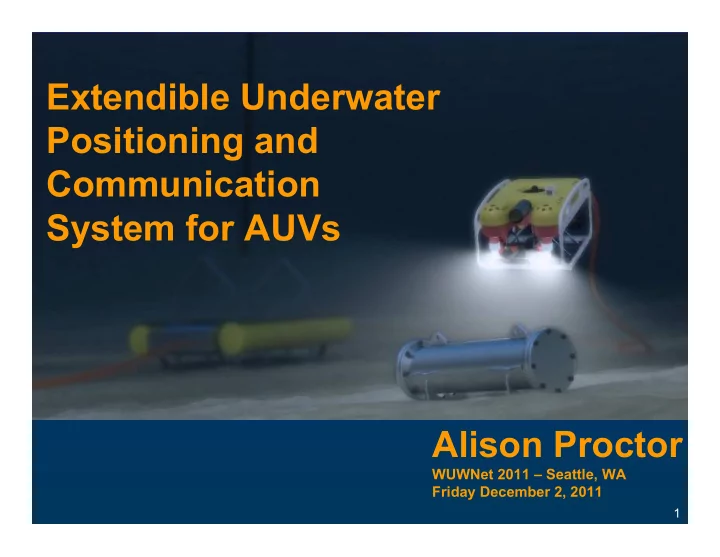

Extendible Underwater Positioning and Communication System for AUVs Alison Proctor WUWNet 2011 – Seattle, WA Friday December 2, 2011 1
Presentation Outline • Conceptual Overview • Potential Applications • Development Facilities at the University of Victoria – Ocean Technology Test Bed – Underwater Vehicles 2
Conceptual Overview Initial Thoughts on the future AUV Operations • Ship time is becoming more difficult to obtain – Aging fleet of vessels for scientific research – More research requires underwater vehicles typically needs dedicated ship time • AUVs are an excellent tool for collecting data on the state of the oceans BUT – Not as easy to operate as some people advertise and can present challenges for an inexperienced crew. – Do require surface support – albeit different from the support required for ROVs • The underwater positioning systems that a currently available commercially were developed with ROV work in mind and the features are not necessarily optimized for AUVs – Often ship centric or take a long time to deploy – Don’t support communication between multiple underwater vehicles 3
Conceptual Overview Objectives • Develop a rapidly deployable seafloor based system that: – Allows a single ship to monitor multiple vehicles working on multiple projects at different sites around the ship – Provides high bandwidth communication between the ship and the work sites – Provides communication between the vehicles on-site – Supports differing levels of positioning accuracy – Installation time can be tailored to the application – Can be migrated to allow a small system to facilitate a large survey area without extensive redeployment time 4
Potential Applications Support Vessel Work Site #2 ROV Small Tending Craft Work Site #1 Work Site #3 5
Conceptual Overview Objectives • Develop a rapidly deployable seafloor based system that: – Allows a single ship to monitor multiple vehicles working on multiple projects at different sites around the ship – Provides high bandwidth communication between the ship and the work sites – Provides communication between the vehicles on-site – Supports differing levels of positioning accuracy – Installation time can be tailored to the application – Can be migrated to allow a small system to facilitate a large survey area 6
Potential Applications 7
Potential Applications Why could this be useful • AUVs with accurate inertial navigation systems are expensive. – External positioning systems allow AUVs with less expensive inertial sensors to perform more useful data collection tasks – Less expensive vehicles are essential to enable the proliferation of AUVs in ocean research • Repeatable navigation solutions anywhere on the globe – High latitude locations or areas with magnetic disturbances can present additional challenges for inertial navigation solutions – These challenges can be mitigated by an accurate local positioning system • Multiple cooperative vehicles are necessary to efficiently collect data – Inter-vehicle communication – High data rate communication to supervising ship – Flexible tools for vehicle supervision 8
Potential Applications Support Vessel Work Site #2 ROV Small Tending Craft Work Site #1 Work Site #3 9
Ocean Technology Test Bed Surface Component • Toroidal buoy on 3 point mooring – Exterior diameter 8m , inner 4m Underwater Platform • Fits inside the buoy and is raised and lowered using a hydraulic winch 6m 2 provided for instrument mounting • • Rise/decent takes 15 minutes • 80 meters of water 10
Ocean Technology Test Bed Platform Control Module (PCM) • Power capabilities: – Nominal power up to 1kW and one high power port which can supply up to 3kW – Voltage, current, and GF monitoring at 1kHz • Gigabit communication capabilities 11
Ocean Technology Test Bed Integrated Acoustic System (IAS) • Cabled Long Baseline System • Real-time tracking – Track multiple targets with update rate of ~1Hz • Static Accuracy: ±10cm ACM • Depth ranges from 65-150m IAS Towers x 5 ~1km ~1km 12
Ocean Technology Test Bed Acoustic Towers • The hydrophone is 7’ off the bottom (not a trawl resistant design) • Single hydrophone and projector – 10-80kHz • Lab style electronics – off the shelf National Instruments hardware – Matlab interface 13
Ocean Technology Test Bed Network Overview • Dedicated 100Mbps connection back to UVic and Internet – Allows users to access streaming video or data. • Clients access the own Virtual LAN (VLAN) through Virtual Private Networking Software (VPN) • Network connectivity is extended to surface vessels through the long range wireless data system. – Coverage over entire operating area with 15Mbps bandwidth – Operators in the boat are in continuous communication with the underwater instruments 14
Ocean Technology Test Bed Other OTTB Assets • 28 ft Tolley Craft work boat – Hydraulic A-frame and winch – Small interior work area • Cable Laying Capabilities • Differential GPS Positioning – +/-2cm accuracy – positions integrated into OTTB tracking system • Saab Sea-Eye Falcon ROV • Bluefin 12 AUV 15
Summary OTTB Application Areas The OTTB is well suited to aid in the development and testing of instrumentation for the following applications • Basic Ocean Technology: AUV and ROV control, acoustic tracking and communications. • Subsea Installations: monitoring subsea equipment and instrumentation, surveys. • Port Security: object location and identification. • Ocean Science: cabled ocean observatories, sea floor mapping, ocean chemistry and biology. • Military Applications: mine detection, surveillance The easy of deployment and remote monitoring system make the OTTB an ideal place for both short and long term research and technology development projects. 16
The End http://web.uvic.ca/~lacir/ocean 17
Recommend
More recommend